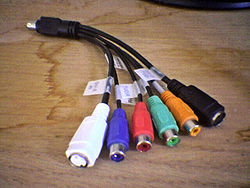Video-in video-out

A 6-connector VIVO splitter cable. From left to right: S-Video In, Component Pb out, Component Pr out, Component Y out/Composite out, Composite in, S-Video Out
|
|||
| Type | Analog video connector | ||
|---|---|---|---|
| Manufacturer | Various graphics card manufacturers | ||
| Width | 10 | ||
| Hot pluggable | Yes | ||
| External | Yes | ||
| Video signal | At least up to 1080p | ||
| Pins | 9 | ||
| Connector | Mini-DIN 9 | ||
 
|
|||
| VIVO port using standard (left) and non-standard (right) Mini-DIN | |||
Video in video out (usually seen as the acronym VIVO and commonly pronounced vee-voh), is a graphics port which enables some video cards to have bidirectional (input and output) analog video transfer through a mini-DIN connector, usually of the 9-pin variety, and a specialised splitter cable (which can sometimes also transfer analog audio).
VIVO is found on high-end ATI and NVIDIA computer video cards, sometimes labeled "TV OUT". VIVO on these graphics cards typically supports composite, component, and S-Video as outputs, and composite and S-Video as inputs. Many other video cards only support component and/or S-Video outputs to complement VGA or DVI, typically using a component breakout cable and an S-Video cable. While component-out operation supports high-definition resolutions, it does not support the HDCP standard which would be required for official HDTV support as set out by the EICTA.
Some practical uses of VIVO include being able to display multimedia stored on a computer on a TV, and being able to connect a DVD player or video game console to a computer while continuing to allow viewing via a TV monitor. VIVO itself, however, can not decode broadcast signals from any source, and so, like HDTV sets without tuners and composite monitors, additional equipment is required to be able to show broadcast TV programs.
...
Wikipedia
